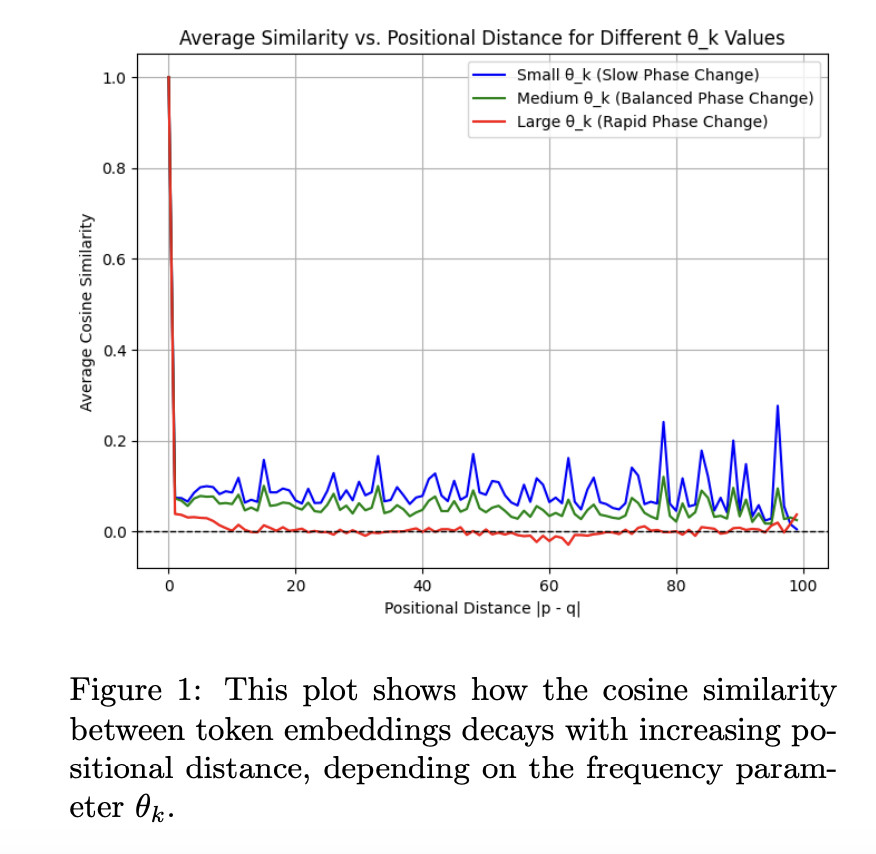

Rotary Positional Embeddings (RoPE) is an advanced approach in artificial intelligence that enhances positional encoding in transformer models, especially for sequential data like language. Transformer models inherently struggle with positional order because they treat each token in isolation. Researchers have explored embedding methods that encode token positions within the sequence to address this, allowing these models to handle ordered data more effectively. Traditional methods focused on sinusoidal or relative encodings, which modify embeddings based on token position but lack the versatility to handle complex sequence dependencies that often span long contexts, especially in autoregressive tasks.
Transformer models face a significant challenge in maintaining contextual information over extended sequences, especially in applications requiring long-term dependencies, such as language understanding and generation. As they progress through a sequence, transformers tend to lose focus on earlier parts, impacting their ability to handle complex or extended contexts. This memory decay poses a significant challenge in autoregressive tasks, demanding that the model retain nuanced temporal and positional information throughout. Addressing this challenge is crucial for advancing model accuracy and performance in real-world applications.
While traditional methods like sinusoidal and relative positional encodings provide transformers with some level of sequential awareness, they often fall short in more intricate sequential tasks. Variants like Transformer-XL extend memory capacity to manage long dependencies but still do not provide explicit modulation of embedding frequency, limiting their effectiveness in handling complex temporal dependencies. These techniques demonstrate foundational progress in encoding position within transformer architectures but lack the depth required for precise long-term memory retention and frequency-based information encoding.
The researchers at the Sapienza University of Rome investigated how RoPE-modulated embeddings interact with transformer models, specifically with feed-forward network (FFN) components. Instead of introducing a new method, the researchers analyzed how activation functions within FFNs engage with RoPE-processed embeddings to produce frequency-based harmonics. These harmonics result from constructive or destructive interference caused by phase alignment or misalignment of embeddings. By examining this interaction, the team provides new insights into the inner workings of RoPE, showing how phase alignment in embeddings significantly enhances model focus and memory retention by amplifying relevant activations. In contrast, phase misalignment reduces model attention to positional details.
The study combined theoretical and empirical analyses to explore RoPE’s effects in autoregressive transformer models like LLaMA 2 and LLaMA 3, where RoPE functions as a method of consistent positional encoding. By examining embeddings after applying RoPE-based rotations, researchers observed how simulated phase shifts influence attention scores. The team used over 1,000 text samples with 200 tokens each and designed synthetic sequences to examine phase interactions in FFNs. Metrics such as variance, kurtosis, and entropy were calculated across different layers to observe behavioral differences in aligned versus misaligned phases. Alignments generally resulted in more stable activation patterns, while misalignment showed higher entropy, suggesting greater instability.
RoPE-modulated embeddings introduce rotation-induced oscillations, causing embeddings to vary in frequency based on position. This modulation, which creates phase shifts, enriches the model’s attention mechanism by adding sensitivity to positional differences. Constructive interference occurs in phase-aligned embeddings, amplifying activations in the model and allowing attention to specific patterns. When phases are misaligned, destructive interference results, weakening attention on certain positional elements and making it harder for the model to retain long-term dependencies.
Through detailed experiments, the researchers observed distinct behaviors between aligned and misaligned sequences regarding stability and activation distribution. In LLaMA 2, aligned sequences often showed stable mean activations, while misaligned sequences exhibited higher kurtosis and entropy as layers deepened, suggesting increased instability. This behavior implies that transformers experience greater difficulty processing positional information when misaligned, affecting coherent information retention over long sequences.
In summary, this research reveals that RoPE’s ability to introduce frequency-based harmonics within transformer embeddings significantly impacts attention focus and memory retention. By investigating the effects of phase alignment and interference, the researchers provided insights into how transformers could better handle sequential data, particularly in tasks requiring both short- and long-term dependencies.
Check out the Paper. All credit for this research goes to the researchers of this project. Also, don’t forget to follow us on Twitter and join our Telegram Channel and LinkedIn Group. If you like our work, you will love our newsletter.. Don’t Forget to join our 55k+ ML SubReddit.
[Trending] LLMWare Introduces Model Depot: An Extensive Collection of Small Language Models (SLMs) for Intel PCs
The post This AI Paper Reveals the Inner Workings of Rotary Positional Embeddings in Transformers appeared first on MarkTechPost.
Source: Read MoreÂ

